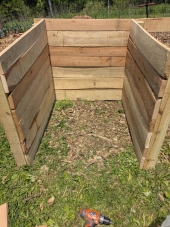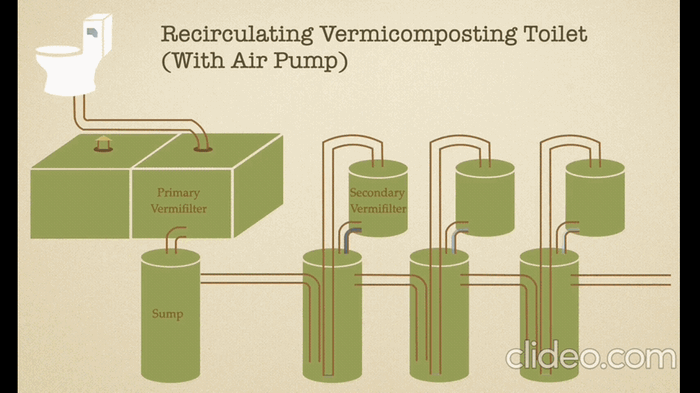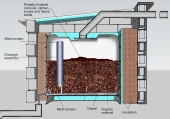This post is in response to requests to keep folks posted on the progress of our flush vermicomposting toilet plans and share some details on how we got our permit approved. This is my first time starting a new topic, and I had been wanting to wait until we started to build, but that got delayed to next Spring. While we've used various compost toilet designs over the years, flushing toilets are what more of my family is willing to adopt indoors.
Because improper waste management is one of the leading causes of death worldwide, I wanted to design the system in a way that gives confidence to approvers. I want to take test data and invite the county approver over to see. I want them to know that a DIY design can still take advantage of the positive strides in protection they are there to hold up. The design would need to manage disease vectors, treat in a way that gives confidence, meet setbacks, uses materials that have been shown to be compatible with waste, uses materials that will last, something I could DIY, wouldn't penalize me for being water conservative, could help me irrigate plants in this arid climate, and doesn't break the bank to build.
Several years ago, when we wanted approval to use the Humanure Handbook method until we could get the flush design approved, I read through the applicable codes and reached out to the county approver. To my surprise, their interpretation on some things was different than what I thought, and I learned that our state directed its approvers to allow "composting" designs. The approver pointed me to the following policy statement on their website:
Incinerating or Composting Toilets - Permanently installed or non-self contained incinerating or composting toilets to the property will require a permit to construct. Permanently installed means that building materials would have to be modified for the installation or removal of the system. Portable incinerating or composting toilets, which are completely self contained, do not require a permit to construct.
As it turns out, the outdoor Humanure Compost bin with periodic 5 gallon bucket deposits was legitimately considered "contained", so it was approved. When I asked about the flush "vermifilter" concept, the approver said the design would need be signed off by a state engineer, which was expected based on my reading of the code. We went ahead and found an engineer willing to work with us, but because we didn't have enough water available at the time, we were forced to hold off. In the mean time, I learned more about the state criteria for reuse of wastewater, got a permit to do surface discharge of greywater, and continued to read technical papers and reach out to more experienced designers. Knowing that our long term goal was to move toward a flush vermifilter design, we went ahead and installed standard house plumbing for future use.
Eventually, I had inspiration to switch from using the technical term "vermifilter" to using the term "vermicomposting toilet", and align with the portable concept. Here's how I worded my next permit inquiry to the county: "I'd like to have a flush toilet that runs into a portable vermicomposting bin. It does not modify building plumbing [uses existing plumbing] and uses any standard toilet. All solids are contained and composted by the worms..." I also provided links to the
Wikipedia vermifilter article which cites numerous technical references, and to two DIY design resources on the web:
vermicompostingtoilets.net and
vermifilter.com. To my surprise, they directed me through a permit-by-rule type of process similar to what I went through to get surface discharge of greywater approved.
The final permit form ended up including a diagram showing that setbacks for a septic system would be met, a notional flush vermicomposting toilet layout diagram with subsurface discharge, which of the reference website designs I would generally follow, effluent design flow numbers per code, and statements about the composting being portable and contained. Because I wanted the capability to surface discharge as greywater and reduce the risk of contaminating our well, I opted for a recirculating design, stated it would generally follow the design at vermifilter.com, provided rationale from technical literature showing that the pathogen reduction targets for surface irrigation could reasonably be met, and stated that more stages could be added if needed. I listed myself as the installer.
For the portable, contained, primary vermicompost bins I've purchased used Snyder Industries square stackable 330gal plastic IBC totes. Compared to standard IBCs, these are much more rugged (1/2in thick walls), have more surface area, and are fully draining. I'm much more confident in those as I've seen a standard IBC tote crack. Redundant IBCs allows for switching between them should one start to get too full, and bins can be replaced should an incompatibility between worms and cleaners is discovered or some other issue occurs.
To minimize the risk of flooding the worms in the IBCs, the inner walls and floor will be lined with drainage cells, then lined inside that with shade cloth. The primary sump will have an emergency overflow to downhill subgrade distribution such that the worms in the IBCs can never back flood. The available surge height will extend into the space created by layers of drainage cells placed on the floor of the IBCs. Recirculating vermicomposting bins will use 55gal HDPE drums lined with layers of coarse plastic drainage netting or something I may 3D print, and then shade cloth, and drainage cells on the floor.
To minimize the risk of freezing the worms, the vermicomposting bins will be subgrade in an insulated area that will eventually be inside a greenhouse. Warm greywater will be routed to the IBC that is not in use by the blackwater. Solar evacuated tubes will be used to heat dedicated water barrels in the room, and a propane buddy burner will be on hand.
For recirculation, we'll use airlift pumps to reduce electricity, add aeration, keep electricity away from water, reduce risk of clogging by any solids, reduce pump noise, and enable easier repair should something fail. The tradeoff for using airlift is a less compact design and more sump depth. We're getting the depth by using dual-wall HDPE culverts with a heat welded bottom. Dual wall HDPE culverts have a straight inner wall to reduce anaerobic nooks, come in various diameters, and can be cut to length and buried. Where pipe penetrations are needed, I'll remove just the outer corrugated wall and use a normal bulkhead fitting to go through the inner wall.
When freezing temperatures prevent surface irrigation, subsurface discharge will irrigate trees and shrubs along contour laterals, using up the nutrient left in the effluent. The current thought on how to do that is to use drainage cells wrapped in geo-textile fabric for the laterals (see
Flo-Log). The drainage cells allow lateral flow while the geo-textile fabric ensures no water is left inside the virtual pipe, significantly reducing the risk of root intrusion. I'll likely use a
Flout to send a surge farther down the laterals and allow time for the surrounding soil to dry out between waterings. I'm also toying with the idea of holding the effluent up by lining just the bottom of the trench, a few inches below the Flo-Log, with plastic to help ensure plants get a drink before it goes too deep, similar to Anna Edey's original design.
I've included a photo below of the IBCs and Culverts, as well as an animation of the recirculating design my daughter did using Apple's Keynote version of PowerPoint, converted to a gif
(click on the gif to animate). Thoughts?









